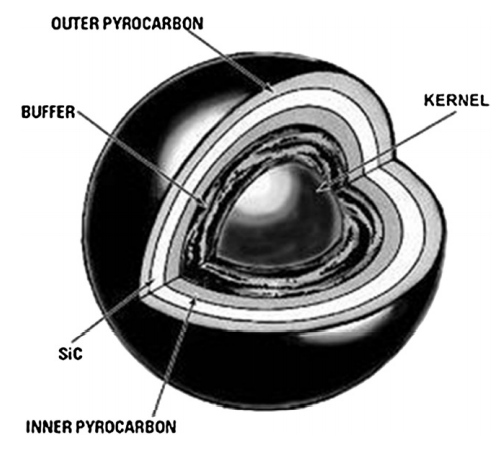TRISO Fuel ( TRi-structural ISOtropic particle fuel )
TRISO stands for TRi-structural ISOtropic particle fuel.
TRISO was invented in the United Kingdom as part of the Dragon reactor project and has been used in many different reactors since. TRISO is currently the fuel form of choice for next generation high-temperature gas-cooled reactors (HTGRs) and very-high-temperature reactors.
The TRISO-coated particle is a spherical, layered composite. The layers that comprise a TRISO particle are the kernel, buffer, inner pyrolytic carbon (IPyC), SiC, and outer pyrolytic carbon (OPyC). Figure depicts an HTGR TRISO particle. The layers within the particle work together as a singular containment system, allowing individual particles to retain fission products under nuclear reactor conditions. TRISO particles are typically ~750-830 µm in diameter (Petti et al. 2004) and vary in size based on kernel type and manufacturing process. There are thousands of these TRISO particles that are combined within a carbon matrix to make an individual fuel compact. Fuel compacts come in two different forms: spherical and cylindrical. Spherical fuel compacts, typically called “pebbles,” are ~6 cm in diameter and are used in pebble bed type reactors (IAEA 1997). Cylindrical fuel compacts are circular cylinders. U.S. design compacts are 12 mm in diameter and 49 mm long and are used in prismatic reactor types (IAEA 1997).
The particles are incredibly small (about the size of a poppy seed) and very robust.
They can be fabricated into cylindrical pellets or billiard ball-sized spheres called “pebbles” for use in either high temperature gas or molten salt-cooled reactors.
TRISO fuels are structurally more resistant to neutron irradiation, corrosion, oxidation and high temperatures (the factors that most impact fuel performance) than traditional reactor fuels.
Each particle acts as its own containment system thanks to its triple-coated layers. This allows them to retain fission products under all reactor conditions.
Simply put, TRISO particles cannot melt in a commercial high-temperature reactor and can withstand extreme temperatures that are well beyond the threshold of current nuclear fuels.

Comments